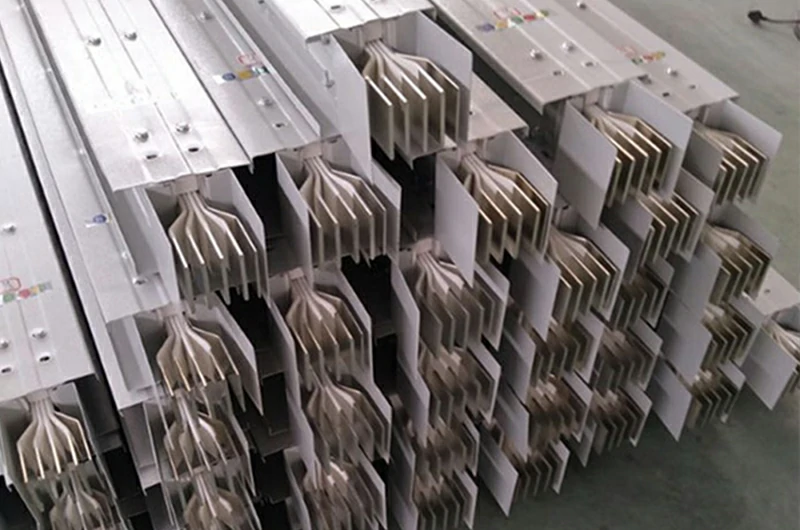Aluminum alloy bus duct is a bus duct made of aluminum-magnesium alloy profiles. Its shell consists of two side panels and upper and lower cover plates. The side panels are designed with heat sinks and dovetail grooves, which are conducive to heat dissipation and enhance the rigidity and installation convenience of the shell.
Mastar can provide a variety of types of aluminum bus ducts, including air type, dense type, fireproof type, etc., to meet the power distribution needs of different scenarios and support customized services.
Specifications for aluminum busway
- International Electrotechnical Commission standard IEC-439
- International Engineering Machinery Association NEMABU1.1 "Bus duct installation and maintenance standards"
- ISO9002, ISO9000 or ISO14000 quality system standards
- JB/T10327-2011 "Fire-resistant busbar trunk system (fire-resistant busbar trunk)"
- GA/T537-2005 "Test methods for flame retardancy, fire prevention and fire resistance of busbar trunk system (busbar trunk)"
Air type aluminum bus duct
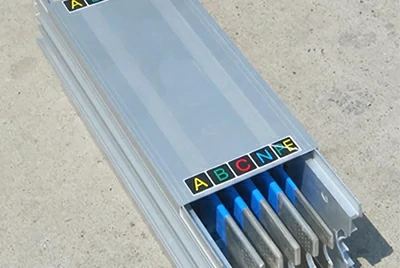
- Air-type aluminum alloy bus duct is a bus duct that uses air insulation between bus bars and an aluminum alloy shell to protect the bus bars and insulators as a whole. Since it relies on air convection to dissipate heat, the heat dissipation effect is relatively general and is suitable for power supply scenarios with small current specifications.
- Rated current value: up to 3150A/4000A
- Heat dissipation principle: The ventilation holes on the shell are convective with the outside air, and the heat dissipation efficiency is low
- Temperature rise: The temperature rise is high
- Protection level: The protection level is low, and dust and particles can easily enter through the heat dissipation holes
- Environmental pollution resistance: Poor anti-pollution ability, not suitable for heavily polluted environments
- Dynamic stability performance: The electric force is concentrated on the insulating support, and the bearing capacity is relatively low
- Insulating medium: Air is used as the insulating medium
- Resistance: Large, affected by the conductor temperature and contact resistance
- Mechanical strength: The busbar is large and heavy, and it is inconvenient to install
- Installation space: Large space requirements
- Installation time: Due to the heavy weight and complex structure, the installation time is long
Intensive aluminum bus duct
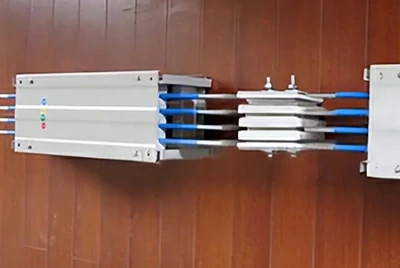
- The dense aluminum alloy bus duct tightly wraps each bus bar with solid insulation material and integrates it into one body, and uses an aluminum alloy shell for protection. Because it relies on conductive heat dissipation, its heat dissipation performance is significantly improved compared to air-type bus ducts, and it is more suitable for power supply needs of large currents.
- Main accessories: connector, start box, plug-in box, spring bracket, hanger, bracket, transition bar, grounding wire, etc.
- Rated current value: up to 6300A
- Heat dissipation principle: the shell is heat-conducting as a whole, the metal has high thermal conductivity, and the heat dissipation efficiency is high
- Temperature rise: low temperature rise
- Protection level: up to IP66, preventing dust and water from entering
- Environmental pollution resistance: strong anti-pollution ability, suitable for heavily polluted environments such as chemical, steel, and wood processing
- Dynamic stability performance: the electric force is evenly distributed on the copper bus and the shell, and can withstand higher short-circuit current
- Insulation medium: organic material, thin, high dielectric strength, good heat resistance
- Resistance: small, low temperature rise, small line voltage drop, small loss
- Mechanical strength: light and compact structure, easy and reliable installation
- Installation space: small space requirement, about 30% reduction
- Installation time: quick installation, single joint screw design is more efficient
High strength aluminum bus duct
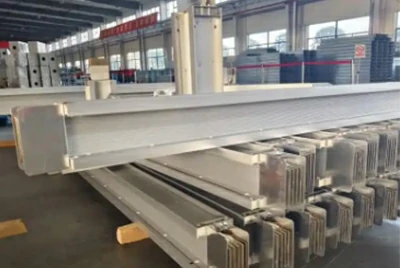
- High-strength aluminum bus duct is a bus duct made of high-strength aluminum alloy material. It has excellent mechanical properties and compressive resistance. It is suitable for large-span and high-load distribution systems. At the same time, it reduces weight and is easy to install.
- Rated current value: 1000A~6300A, supports high current load
- Heat dissipation principle: high thermal conductivity aluminum alloy shell, heat dissipation coefficient is about 210 W/m·K, natural convection and radiation heat dissipation are combined, and the heat dissipation efficiency is high
- Temperature rise: excellent temperature rise control, usually ≤35℃, maximum not exceeding 40℃
- Protection level: IP65~IP67, can meet dust and waterproof requirements
- Anti-environmental pollution: can adapt to humidity of 85%~100%, salt spray test for 96 hours without abnormality, suitable for highly corrosive industrial environment
- Dynamic stability performance: dynamic stability current can reach 50~120kA (1 second), the shell and busbar work together to withstand short-circuit impact
- Insulation medium: insulation withstand voltage ≥3000V, heat resistance up to 200℃, insulation resistance ≥100MΩ
- Resistance: total bus resistance ≤0.015Ω/km, using high-purity aluminum conductor (purity ≥99.7%), conductivity about 62% IACS
- Mechanical strength: shell compressive strength ≥200MPa, tensile strength ≥280MPa, meet the requirements of large-span installation, each span support length can reach more than 6 meters
- Installation space: suitable for large-span design, reduce the number of support points, can be installed in spans, save building space
- Installation time: about 20% to 30% lighter, modular design, suitable for rapid installation in large-span areas, installation time is shortened by 30% to 50% compared with traditional busbars
- Reduction: even under tilted (0 to 45°) or vertical installation conditions, no additional reduction is required
- Chimney effect: internal gap design is optimized, no chimney effect is generated, and the spread of fire is effectively suppressed in a fire environment
- Others: anodized aluminum surface, corrosion resistance increased by 50%; materials can be 100% recycled, in line with green environmental protection requirements
Refractory aluminum busway
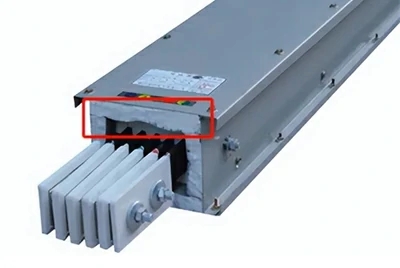
- Aluminum bus ducts can maintain circuit integrity for a specified period of time under flame conditions. The insulation material of fire-resistant bus ducts is conventional non-combustible materials, and flame-retardant materials are also used.
- Rated current value: supports 1000A~6300A, meeting the needs of high current load
- Temperature rise: The temperature rise is controlled at ≤40℃, and the temperature rise is kept stable under fire-resistant conditions
- Protection level: The protection level can reach IP67, with dustproof and waterproof capabilities, and excellent performance in fire environments
- Insulation medium: High temperature resistant insulation materials are used, the insulation withstand voltage is ≥3000V, and the heat resistance can reach 200℃, ensuring reliable insulation performance in fires
- Resistance: The total resistance of the busbar is ≤0.015Ω/km, the line loss is low, and the conductive performance is stable in fire environments
Common alloys for aluminum bus duct
1060/1070 aluminum bus duct
- High conductivity: The aluminum content is as high as 99.6% or more, and the conductivity is close to pure aluminum, usually 61%-63% IACS (International Annealed Copper Standard).
- Good corrosion resistance: It has high corrosion resistance and is particularly suitable for use in humid or chemical environments.
- Low cost: Due to the simple composition, the production cost is low and the cost performance is high.
6101 aluminum busway
- High conductivity and strength: As an electrical aluminum alloy, 6101 has good mechanical strength while ensuring high conductivity (about 55% IACS).
- Easy processing: It has good extrudability and is suitable for producing conductor materials with complex shapes.
- Strong heat resistance: It is suitable for power transmission in high temperature environments.
Electrical performance of aluminum alloy bus duct
- Rated voltage: 380V/660V; Rated insulation voltage: 1000V AC;
- Rated frequency: 50HZ; Current range: 400A-6300A;
- Heat resistance grade ≧B grade; Insulation grade ≧B grade
- Power frequency withstand voltage: 3500V AV, no breakdown, no flashover.
Insulation materials for aluminum bus duct
Material requirements
- Good insulation performance, considering that the long-term working temperature cannot be lower than 105℃;
- Flame retardant, no carbonization, no toxic gas when decomposed; aging resistant.
Material type
- Polyester film: The commonly used insulating material is (DuPont) polyester film, which does not affect the insulation performance under the conditions of temperature 130 degrees and voltage 10000V, and has high cost performance.
- Polytetrafluoroethylene tape: high temperature resistance, corrosion resistance, low temperature resistance and power saving performance, but it produces toxic gas harmful to the human body when decomposed at high temperature.
- Polyimide winding tape: corrosion resistance, aging resistance and insulation performance, as well as nuclear radiation resistance, can be used in atomic reactors, but the fire resistance is poor and cannot be used as a fire-resistant insulation material.
- Mica winding tape: insulation and high temperature resistance, can be used for fire-resistant bus ducts.
What are the components of bus duct?
- Linear bus duct unit: It is used to extend the power supply and distribution line. The closed bus duct with tapping device is used with the plug-in box to distribute the power load.
- Plug-in box: It is used to lead out the power outlet on the closed bus duct. The plug-in box is equipped with an automatic air switch to cut off and connect the power.
- Starting bus duct unit: It is matched with the starting incoming line box to form the connection part between the bus duct and the cable. The starting bus duct unit can also be connected to the transformer or distribution cabinet.
- Bus duct terminal box: It is used for the terminal end of the closed bus duct to ensure the power supply safety of the bus duct system.
- Variable diameter bus duct unit: It is used to connect different rated current units in the same system to make the power supply of the entire bus duct system more economical and reasonable.
- Expansion bus duct unit: It is used to absorb the axial change of the bus duct caused by thermal expansion. When the length of the bus duct exceeds 80m, an expansion bus duct unit should be installed.
- Bend connection unit: There are four types: L-type, T-type, Z-type, and cross-type. They are used for connecting and changing the direction of horizontal and vertical power supply and distribution, and can flexibly connect the bus duct system.
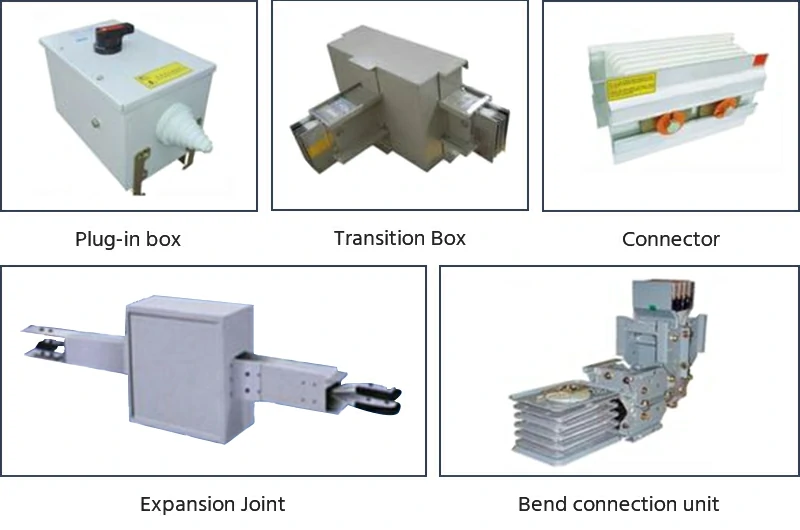
The difference between copper conductor and aluminum conductor of bus duct
| Comparison Item | Copper Conductor | Aluminum Conductor |
| Conductivity | High conductivity, approx. 58.5 MS/m (100% IACS) | Lower conductivity, approx. 36 MS/m (62% IACS) |
| Weight | High density, 8.96 g/cm³, overall heavier | Low density, 2.7 g/cm³, about 1/3 the weight of copper, lighter for large span installation |
| Mechanical Strength | High tensile strength, suitable for high strength applications | Lower tensile strength, but can be improved through alloying |
| Corrosion Resistance | Good corrosion resistance, forms a protective layer, strong oxidation resistance | Pure aluminum has weaker corrosion resistance, but can be enhanced by anodizing and surface treatments |
| Temperature Rise | Low temperature rise, superior conductivity, low resistivity (~0.017 μΩ·m), minimal line loss | Higher temperature rise, relatively higher resistivity (~0.027 μΩ·m), but performance can approach copper with optimized design |
| Cost | Higher raw material cost, significantly more expensive than aluminum conductors | Lower raw material cost, cost-effective, especially for long-distance and high current applications |
| Ease of Installation | Heavy, requires stronger mechanical support for installation | Lightweight design, easier to transport and install |
| Thermal Expansion Coefficient | Low thermal expansion, approx. 16.5 × 10⁻⁶ /℃, stable dimensions in high temperature environments | Higher thermal expansion, approx. 23.1 × 10⁻⁶ /℃, requires consideration of thermal expansion at joints |
| Recyclability | High recycling value, retains good conductivity after recycling | Recyclable, but economic value is lower than copper |
| Application Scenarios | Suitable for applications requiring high conductivity, oxidation resistance, and mechanical strength, such as heavy industry and high-end electrical equipment | Suitable for cost-sensitive applications requiring lightweight design, such as commercial buildings and large span installations |
How to choose a suitable bus duct?
For the installation site, the first consideration is the protection level of the duct shell, followed by the influence of the building structure on the appearance of the duct, the form of the mounting bracket and the span.
For indoor special workplaces, such as large-capacity substations, to improve the heat dissipation effect, IP30-level bus ducts can be used; for ordinary indoor work, such as floor electrical shafts and distribution rooms, to ensure safety, bus ducts with a level of not less than IP40 should be used.
For indoor humid places or those with splash-proof requirements, to ensure that they can still work normally when splashed, bus ducts with a level of not less than IP54 should be used.
For outdoor or special requirements, such as water spray, wave and corrosion-resistant places, resin insulated bus ducts can be used separately.
For large-span places, shell-reinforced bus ducts should be used; for rated current, comprehensive consideration should be given to technical performance, heat dissipation effect, price and other aspects. At present, the market mostly uses aluminum alloy shell low-impedance dense insulated bus ducts with excellent heat dissipation performance and low energy consumption.


